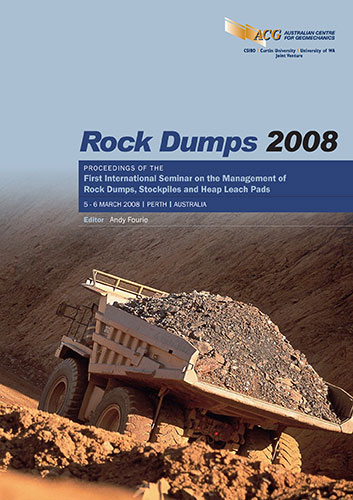Savage River Mine — Rock Dump Evolution

|
Authors: Brett, DM; Hutchison, BJ; Kent, s |
DOI https://doi.org/10.36487/ACG_repo/802_3
Cite As:
Brett, DM, Hutchison, BJ & Kent, s 2008, 'Savage River Mine — Rock Dump Evolution', in AB Fourie (ed.), Rock Dumps 2008: Proceedings of the First International Seminar on the Management of Rock Dumps, Stockpiles and Heap Leach Pads, Australian Centre for Geomechanics, Perth, pp. 33-45, https://doi.org/10.36487/ACG_repo/802_3
Abstract:
Operations at the Savage River mine on the west coast of Tasmania commenced in 1966 with magnetite ore being mined in a series of open pits. The steep hillside terrain and temperate rainforest environment made waste rock dumping difficult with poor practice leading to the oxidation of pyritic rock wastes in the older hillside dumps with the development of acid rock drainage (ARD). Historically, waste rock was either being placed on steep hillside dumps or on ridges above steep sided valleys. The hillside dumps were prone to slope failures, which lead to blocked and/or polluted creeks, and the ridge top dumps were becoming uneconomic due to the long steep climbs. The key to development of the mine was construction of a “flow-through” dump in Broderick Creek, adjacent to and a short haul from the main North Pit. This significantly increased the practicality of dump construction and allowed practical cellular construction with encapsulation of potentially acid forming (PAF) rocks. The other problem with high dumps on steep hillsides in the wet climate was the placement and compaction of clay at relatively low angles required for stability. A simplified construction technique based on end tipping of silty-clay material over the sides of the PAF rocks and then armouring this with alkaline rock was adopted. Using this technique provides a thick zone of partially saturated soil sufficient to exclude oxygen. The armoured alkaline rock acts to increase saturation and to stabilise the clay. It also reduces the prospect of vegetative regrowth destroying the dump cover integrity. The paper describes the evolution of waste rock dumps at Savage River mine and particularly focuses on monitoring of the current capping systems.
References:
Brett, D. and Hutchison, B.J. (2003) Design and Performance of a “Flow – Through” Spillway at Broderick Creek Waste
Rock Dump –Savage River mine, Australian Journal of Water Resources, Vol. 6, No. 2.
Brett, D. (2006) Strategic Planning For ARD Remediation, 7th ICARD, March 26-30, St Louis MO. Published by
ASMR, 3134 Montavesta Rd., Lexington, KY 40502.
Hutchison, B.J. (2006) SRRP - B Dump Water Shedding Cover-Construction Report, October 2006.
Rumble, C. (2000) Presentation to Australian Bulk Minerals at Savage River Mine, unpublished.
Geotechnical Issues – Strength, Stability and Seepage
Rock Dumps 2008, Perth, Australia 45
© Copyright 2024, Australian Centre for Geomechanics (ACG), The University of Western Australia. All rights reserved.
View copyright/legal information
Please direct any queries or error reports to repository-acg@uwa.edu.au
View copyright/legal information
Please direct any queries or error reports to repository-acg@uwa.edu.au